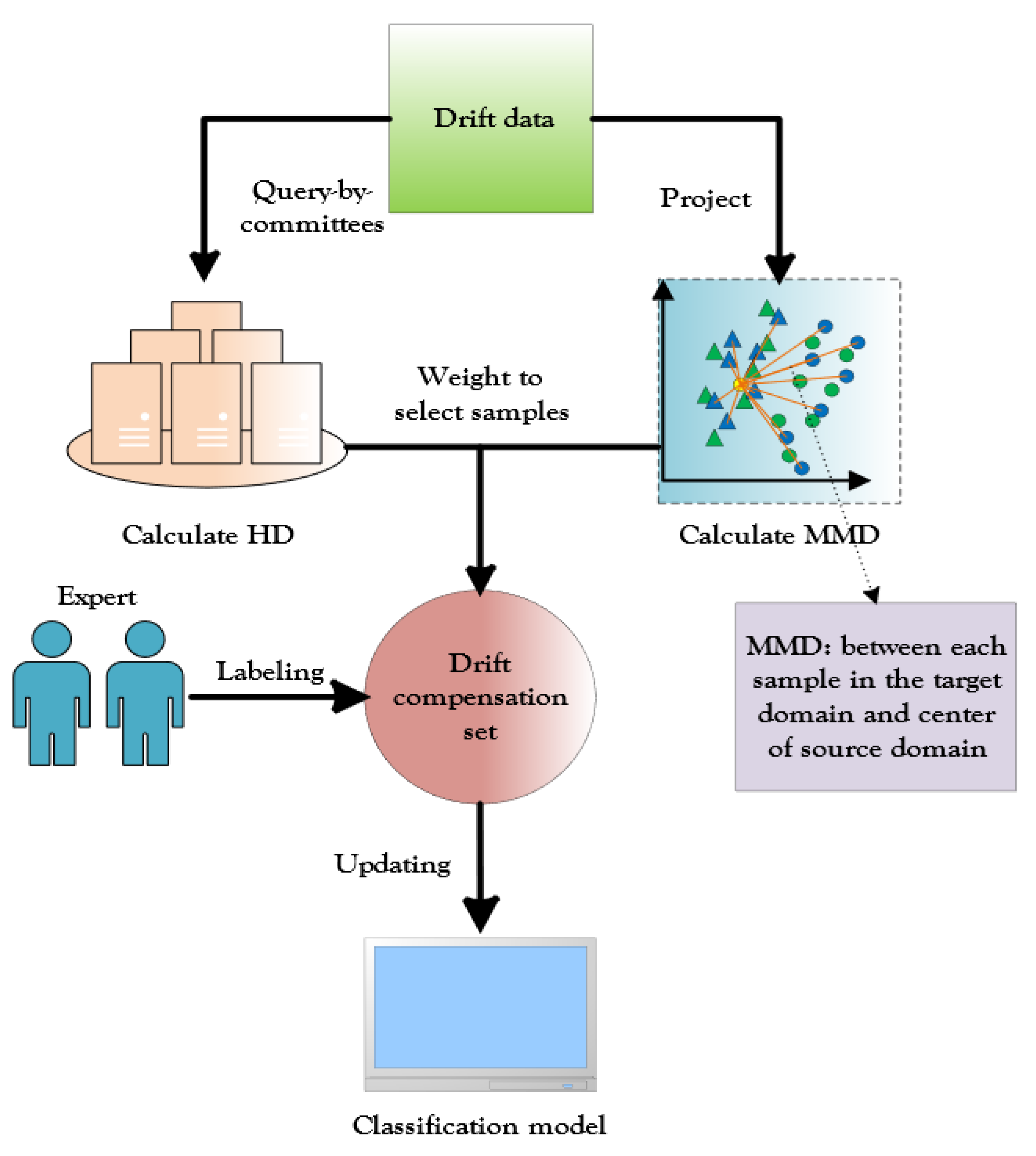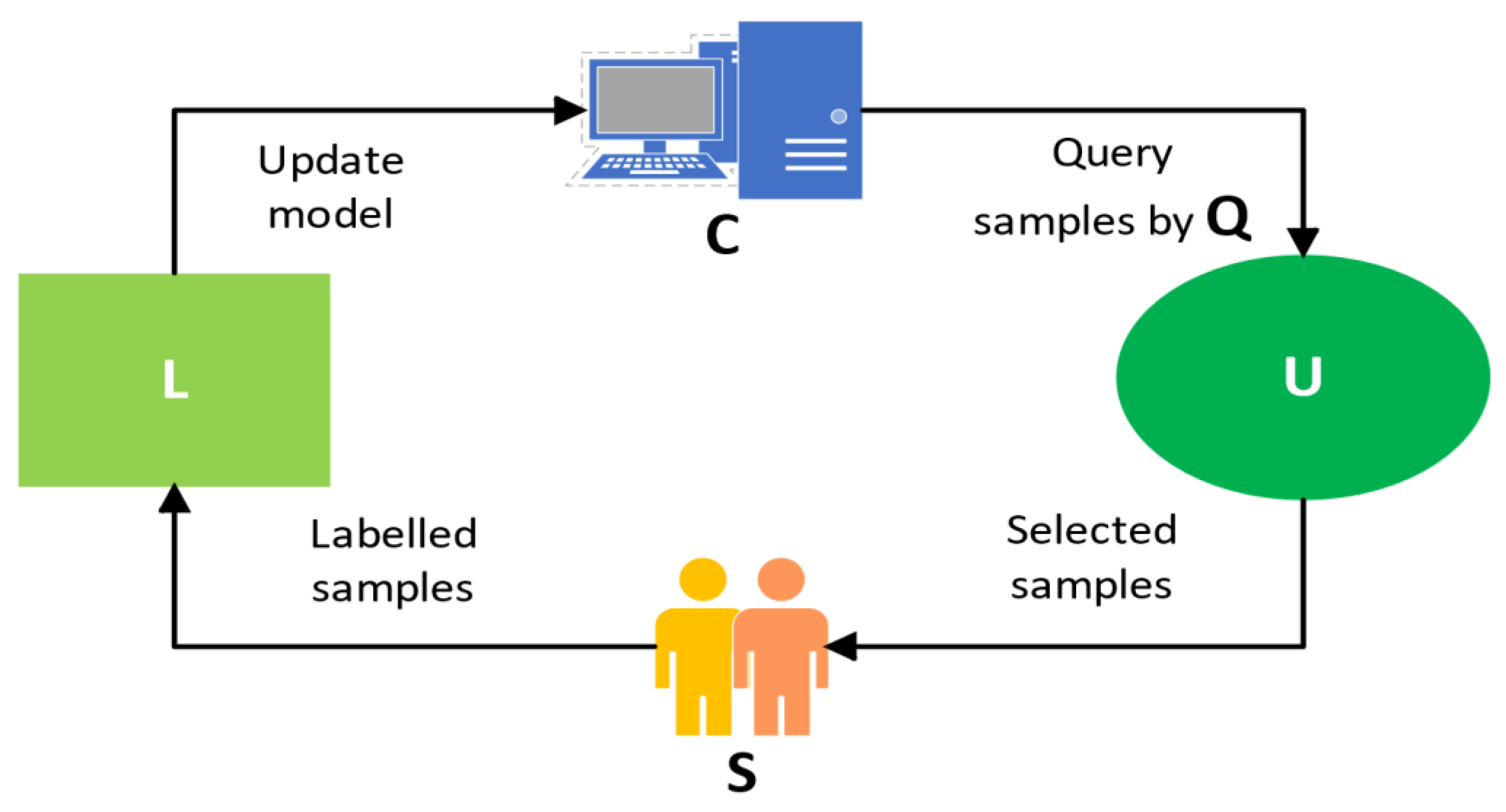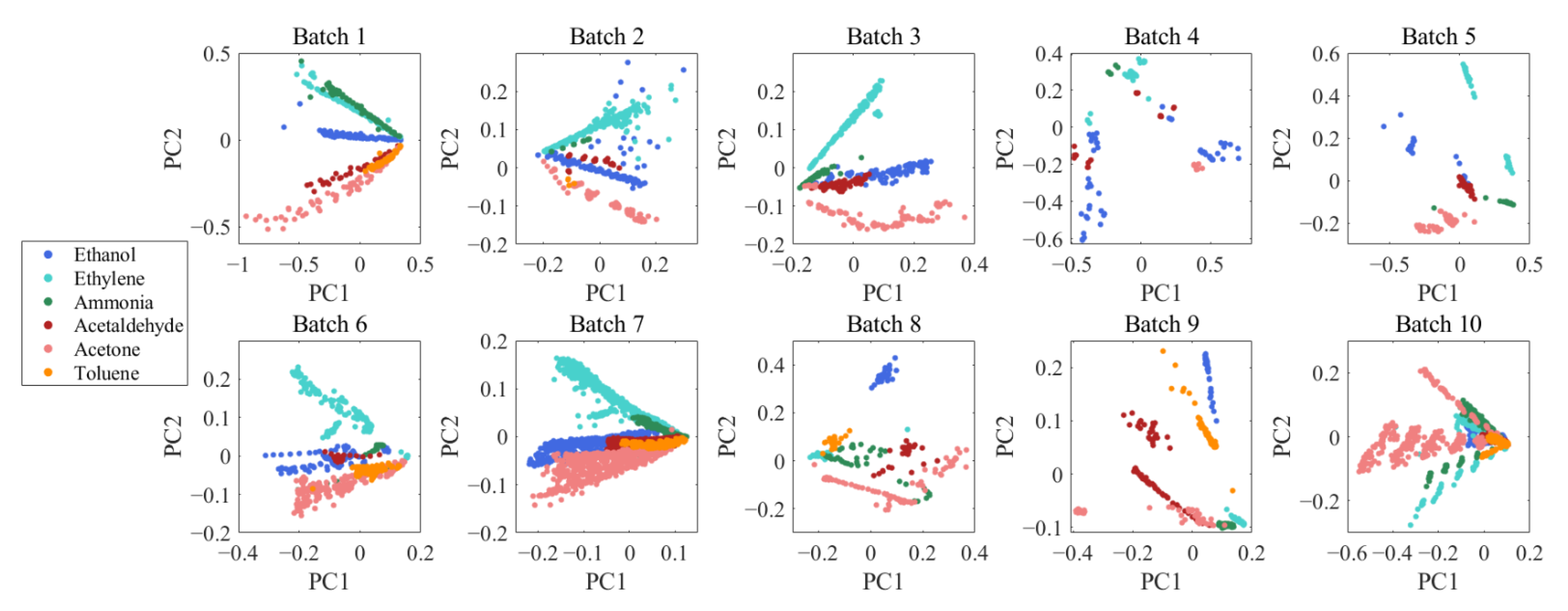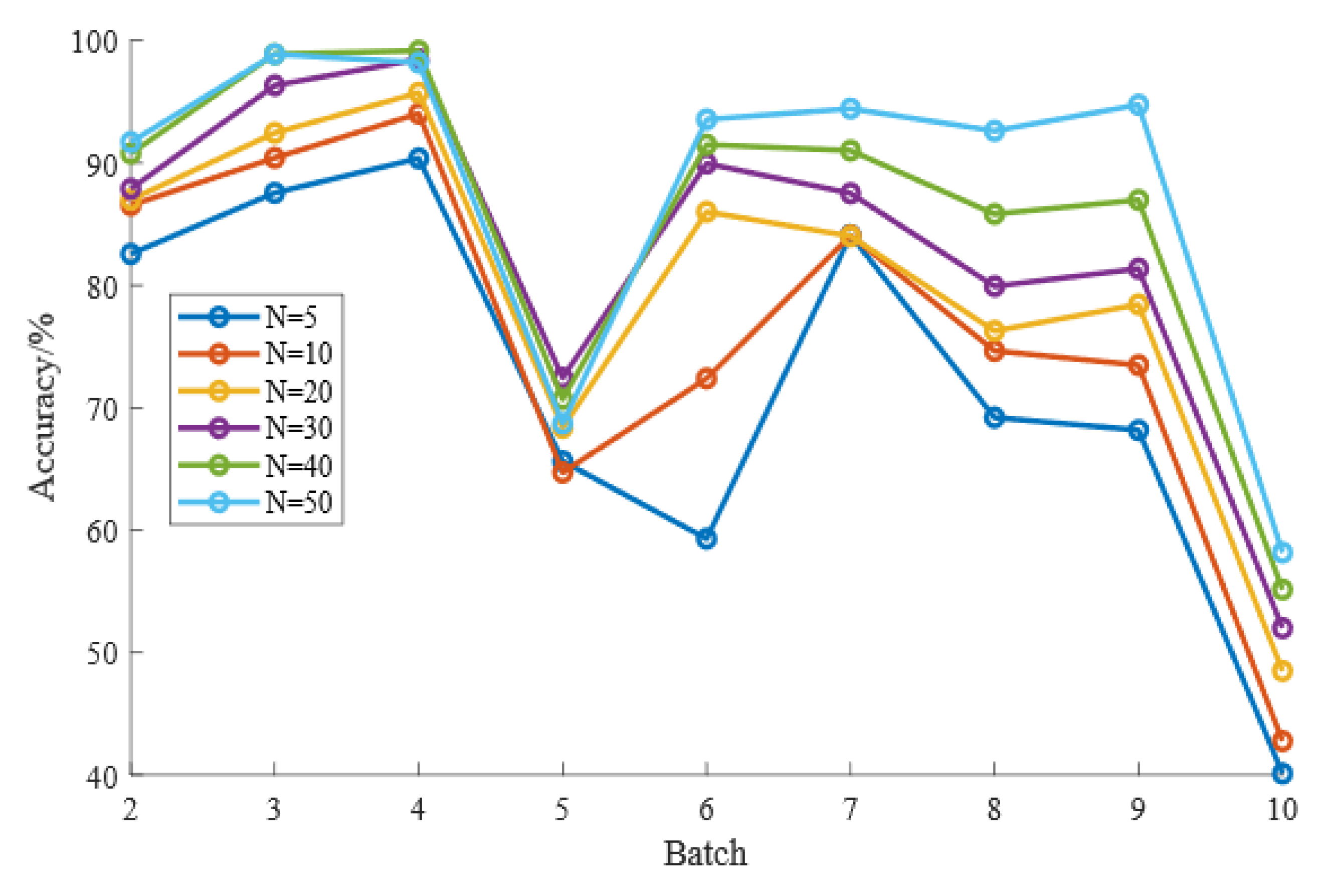Cross-Domain Active Learning for Electronic Nose Drift Compensation
Abstract
:1. Introduction
- (1)
- The framework consists of a combination of active learning and domain adaptation, which makes full use of the distribution differences in migration distributions of samples between different domains while considering the degree of disagreement among committee members on the classification results of the sample.
- (2)
- HD is used as a measure of the divergence of the enquiry committee’s output and is more appropriate for sample selection than the usual discrete judgement criteria.
- (3)
- The MMD is able to measure the distributional variability between the source and target domains, greatly facilitating the selection of more representative samples for modification of the classification model in active learning.
- (4)
- The mapping of Gaussian functions allows us to represent the distance between distributions by the inner product of points, which can be used to assess the impact of differences in the distribution of data due to drift.
- (5)
- Experiments show that CDAL is significantly effective in both drift suppression and pattern recognition.
2. Related Work
2.1. Review of Drift Compensation of E-Nose
2.2. Review of Active Learning
3. Methodology
3.1. Notations
3.2. Cross-Domain Active Learning Approach
| Algorithm 1 Proposed CDAL Algorithm |
| Input: sample query set U, training set , test set . n: number of samples in each query set U. N: number of selected samples. Output: updated training set ,updated test set . 1: Initialize U = . 2: for i = 1: do 3: Calculate the HD for each sample in U by the probability distribution of the committee members’ predictions through Equation (3). 4: Calculate the MMD between each sample in the query set U and the entire training set through Equation (5). 5: Calculate the weighted sum of HD and MMD with optimized weight parameterthrough Equation (9). 6: end for 7: Select samples with the largest from U as the selected sample set . 8: Label with category by experts. 9: Update , : ←, 10: Update ←, 11: Return training set , test set . |
4. Experiments and Results
4.1. Dataset
4.2. Experimental Setup
4.3. Experimental Results under Setting 1
- (1)
- Our CDAL method has the best recognition results among all the compared methods under the same experimental conditions, and the average recognition accuracy is almost 10% higher than all the other methods.
- (2)
- The direct use of SVM and ELM classification was the worst. Among them, the migration learning methods CDSL and DRCA were able to achieve recognition accuracy of 69.59% and 58.72%, which was slightly better than that of the baseline methods. This indicates that the introduction of domain adaptation considering the interdomain distribution problem can improve the E-nose drift compensation effect.
- (3)
- The recognition accuracy of the AL-KLD, AL-JSD, AL-HD, and CDAL methods that used sample selection methods were all above 65%, which was significantly better than the other methods. This also shows that using a small amount of target domain data for labeling can greatly improve the classification accuracy, which is worthwhile and effective.
4.4. Experimental Results under Setting 2
- (1)
- The CDAL method we used still has the best results in dealing with short-term drift, and with a selected sample of 30, the average recognition accuracy can reach over 82%, which far exceeds the other methods. This indicated that our CDAL method has better identification and robustness than other methods and was very effective in dealing with the short-term drift of the E-nose.
- (2)
- AL-KLD, AL-HD, AL-JSD, and CDAL, as the methods using sample selection, achieved an average recognition accuracy of over 70%, which indicates that selecting an appropriate sample selection criterion for E-nose drift compensation can greatly improve recognition performance. This also shows that the method of obtaining a very small number of target domain labels is worthwhile and effective.
- (3)
- The recognition accuracy of CDSL as a migration learning method can also reach 75.58%, which indicates that in the process of drift compensation of the E-nose system, the difference in data distribution caused by drift needs to be solved, which also provides a reference for our CDAL model.
4.5. Parameter Sensitivity Analysis
5. Conclusions
Author Contributions
Funding
Institutional Review Board Statement
Informed Consent Statement
Data Availability Statement
Acknowledgments
Conflicts of Interest
References
- Chilo, J.; Pelegri-Sebastia, J.; Cupane, M.; Sogorb, T. E-Nose Application to Food Industry Production. IEEE Instrum. Meas. Mag. 2016, 19, 27–33. [Google Scholar] [CrossRef]
- Bieganowski, A.; Józefaciuk, G.; Bandura, L.; Guz, Ł.; Łagód, G.; Franus, W. Evaluation of Hydrocarbon Soil Pollution Using E-Nose. Sensors 2018, 18, 2463. [Google Scholar] [CrossRef] [Green Version]
- Goor, R.; Hooren, M.; Dingemans, A.-M.; Kremer, B.; Kross, K. Training and Validating a Portable Electronic Nose for Lung Cancer Screening. J. Thorac. Oncol. 2018, 13, 676–681. [Google Scholar] [CrossRef] [Green Version]
- Yan, J.; Duan, S.; Huang, T.; Wang, L. Hybrid Feature Matrix Construction and Feature Selection Optimization-Based Multi-Objective QPSO for Electronic Nose in Wound Infection Detection. Sens. Rev. 2016, 36, 23–33. [Google Scholar] [CrossRef]
- Zhang, L.; Liu, Y.; He, Z.; Liu, J.; Deng, P.; Zhou, X. Anti-Drift in E-Nose: A Subspace Projection Approach with Drift Reduction. Sens. Actuators B Chem. 2017, 253, 407–417. [Google Scholar] [CrossRef]
- Zuppa, M. Drift Counteraction with Multiple Self-Organising Maps for an Electronic Nose. Sens. Actuators B Chem. 2004, 98, 305–317. [Google Scholar] [CrossRef]
- Haugen, J.-E.; Tomic, O.; Kvaal, K. A Calibration Method for Handling the Temporal Drift of Solid State Gas-Sensors. Anal. Chim. Acta 2000, 407, 23–39. [Google Scholar] [CrossRef]
- Yan, K.; Zhang, D. Improving the Transfer Ability of Prediction Models for Electronic Noses. Sens. Actuators B Chem. 2015, 220, 115–124. [Google Scholar] [CrossRef]
- Tomic, O.; Ulmer, H.; Haugen, J.-E. Standardization Methods for Handling Instrument Related Signal Shift in Gas-Sensor Array Measurement Data. Anal. Chim. Acta 2002, 472, 99–111. [Google Scholar] [CrossRef]
- Kermit, M.; Tomic, O. Independent Component Analysis Applied on Gas Sensor Array Measurement Data. IEEE Sens. J. 2003, 3, 218–228. [Google Scholar] [CrossRef]
- Artursson, T.; Eklöv, T.; Lundström, I.; Mårtensson, P.; Sjöström, M.; Holmberg, M. Drift Correction for Gas Sensors Using Multivariate Methods. J. Chemom. 2000, 14, 711–723. [Google Scholar] [CrossRef]
- Ziyatdinov, A.; Marco, S.; Chaudry, A.; Persaud, K.; Caminal, P.; Perera, A. Drift Compensation of Gas Sensor Array Data by Common Principal Component Analysis. Sens. Actuators B Chem. 2010, 146, 460–465. [Google Scholar] [CrossRef] [Green Version]
- Padilla, M.; Perera, A.; Montoliu, I.; Chaudry, A.; Persaud, K.; Marco, S. Drift Compensation of Gas Sensor Array Data by Orthogonal Signal Correction. Chemom. Intell. Lab. Syst. 2010, 100, 28–35. [Google Scholar] [CrossRef]
- Tao, Y.; Xu, J.; Liang, Z.; Xiong, L.; Yang, H. Domain Correction Based on Kernel Transformation for Drift Compensation in the E-Nose System. Sensors 2018, 18, 3209. [Google Scholar] [CrossRef] [Green Version]
- Zhang, L.; Liu, Y.; Deng, P. Odor Recognition in Multiple E-Nose Systems with Cross-Domain Discriminative Subspace Learning. IEEE Trans. Instrum. Meas. 2017, 66, 1679–1692. [Google Scholar] [CrossRef]
- Tian, Y.; Yan, J.; Yi, D.; Zhang, Y.; Wang, Z.; Yu, T.; Peng, X.; Duan, S. Local Manifold Embedding Cross-Domain Subspace Learning for Drift Compensation of Electronic Nose Data. IEEE Trans. Instrum. Meas. 2021, 70, 1–12. [Google Scholar] [CrossRef]
- Wang, Z.; Yan, J.; Chen, F.; Peng, X.; Zhang, Y.; Wang, Z.; Duan, S. Sensor Drift Compensation of E-Nose Systems with Discriminative Domain Reconstruction Based on an Extreme Learning Machine. IEEE Sens. J. 2021, 21, 17144–17153. [Google Scholar] [CrossRef]
- Yi, R.; Yan, J.; Shi, D.; Tian, Y.; Chen, F.; Wang, Z.; Duan, S. Improving the Performance of Drifted/Shifted Electronic Nose Systems by Cross-Domain Transfer Using Common Transfer Samples. Sens. Actuators B Chem. 2021, 329, 129162. [Google Scholar] [CrossRef]
- Yan, J.; Chen, F.; Liu, T.; Zhang, Y.; Peng, X.; Yi, D.; Duan, S. Subspace Alignment Based on an Extreme Learning Machine for Electronic Nose Drift Compensation. Knowl.-Based Syst. 2022, 235, 107664. [Google Scholar] [CrossRef]
- Zhang, Y.; Xiang, S.; Wang, Z.; Peng, X.; Tian, Y.; Duan, S.; Yan, J. TDACNN: Target-Domain-Free Domain Adaptation Convolutional Neural Network for Drift Compensation in Gas Sensors. Sens. Actuators B Chem. 2022, 361, 131739. [Google Scholar] [CrossRef]
- Zhang, L.; Zhang, D. Domain Adaptation Extreme Learning Machines for Drift Compensation in E-Nose Systems. IEEE Trans. Instrum. Meas. 2015, 64, 1790–1801. [Google Scholar]
- Ma, Z.; Luo, G.; Qin, K.; Wang, N.; Niu, W. Weighted Domain Transfer Extreme Learning Machine and Its Online Version for Gas Sensor Drift Compensation in E-Nose Systems. Wirel. Commun. Mob. Comput. 2018, 2018, 2308237. [Google Scholar] [CrossRef] [Green Version]
- Tian, Y.; Yan, J.; Zhang, Y.; Yu, T.; Wang, P.; Shi, D.; Duan, S. A Drift-Compensating Novel Deep Belief Classification Network to Improve Gas Recognition of Electronic Noses. IEEE Access 2020, 8, 121385–121397. [Google Scholar] [CrossRef]
- Vergara, A.; Vembu, S.; Ayhan, T.; Ryan, M.A.; Homer, M.L.; Huerta, R. Chemical Gas Sensor Drift Compensation Using Classifier Ensembles. Sens. Actuators B Chem. 2012, 166–167, 320–329. [Google Scholar]
- Magna, G.; Martinelli, E.; D’Amico, A.; Di Natale, C. An Ensemble of Adaptive Classifiers for Improving Faulty and Drifting Sensor Performance. Procedia Eng. 2012, 47, 1275–1278. [Google Scholar] [CrossRef] [Green Version]
- Liu, H.; Tang, Z. Metal Oxide Gas Sensor Drift Compensation Using a Dynamic Classifier Ensemble Based on Fitting. Sensors 2013, 13, 9160–9173. [Google Scholar] [CrossRef] [Green Version]
- Verma, M.; Asmita, S.; Shukla, K.K. A Regularized Ensemble of Classifiers for Sensor Drift Compensation. IEEE Sens. J. 2016, 16, 1310–1318. [Google Scholar] [CrossRef]
- Zhao, X.; Li, P.; Xiao, K.; Meng, X.; Han, L.; Yu, C. Sensor Drift Compensation Based on the Improved LSTM and SVM Multi-Class Ensemble Learning Models. Sensors 2019, 19, 3844. [Google Scholar]
- Rehman, A.U.; Belhaouari, S.B.; Ijaz, M.; Bermak, A.; Hamdi, M. Multi-Classifier Tree with Transient Features for Drift Compensation in Electronic Nose. IEEE Sens. J. 2021, 21, 6564–6574. [Google Scholar] [CrossRef]
- Liu, T.; Li, D.; Chen, J.; Chen, Y.; Yang, T.; Cao, J. Active Learning on Dynamic Clustering for Drift Compensation in an Electronic Nose System. Sensors 2019, 19, 3601. [Google Scholar]
- Liu, T.; Li, D.; Chen, Y.; Wu, M.; Yang, T.; Cao, J. Online Drift Compensation by Adaptive Active Learning on Mixed Kernel for Electronic Noses. Sens. Actuators B Chem. 2020, 316, 128065. [Google Scholar] [CrossRef]
- Li, Q.; Wu, P.; Liang, Z.; Tao, Y. Research on Electronic Nose Drift Suppression Algorithm Based on Classifier Integration and Active Learning. In Proceedings of the 2021 13th International Conference on Communication Software and Networks (ICCSN), Chongqing, China, 4–7 June 2021; pp. 277–282. [Google Scholar]
- Liu, T.; Li, D.; Chen, J. An Active Method of Online Drift-Calibration-Sample Formation for an Electronic Nose. Measurement 2021, 171, 108748. [Google Scholar] [CrossRef]
- Cao, J.; Liu, T.; Chen, J.; Yang, T.; Zhu, X.; Wang, H. Drift Compensation on Massive Online Electronic-Nose Responses. Chemosensors 2021, 9, 78. [Google Scholar] [CrossRef]
- Fernandez, L.; Guney, S.; Gutierrez-Galvez, A.; Marco, S. Calibration Transfer in Temperature Modulated Gas Sensor Arrays. Sens. Actuators B Chem. 2016, 231, 276–284. [Google Scholar] [CrossRef] [Green Version]





| Batch ID | Month | Acetone | Acetaldehyde | Ethanol | Ethylene | Ammonia | Toluene | Total |
|---|---|---|---|---|---|---|---|---|
| Batch 1 | 1–2 | 90 | 98 | 445 | 30 | 70 | 74 | 445 |
| Batch 2 | 3–10 | 164 | 334 | 1244 | 109 | 532 | 5 | 1244 |
| Batch 3 | 11–13 | 365 | 490 | 1586 | 240 | 275 | 0 | 586 |
| Batch 4 | 14–15 | 64 | 43 | 161 | 30 | 12 | 0 | 161 |
| Batch 5 | 16 | 28 | 40 | 197 | 46 | 63 | 0 | 197 |
| Batch 6 | 17–20 | 514 | 574 | 2300 | 29 | 606 | 467 | 2300 |
| Batch 7 | 21 | 649 | 662 | 3613 | 744 | 630 | 568 | 3613 |
| Batch 8 | 22–23 | 30 | 30 | 294 | 33 | 143 | 18 | 294 |
| Batch 9 | 24,30 | 61 | 55 | 470 | 75 | 78 | 101 | 470 |
| Batch 10 | 36 | 600 | 600 | 600 | 600 | 600 | 600 | 3600 |
| Method | 1–2 | 1–3 | 1–4 | 1–5 | 1–6 | 1–7 | 1–8 | 1–9 | 1–10 | Average |
|---|---|---|---|---|---|---|---|---|---|---|
| SVM | 47.99 | 57.57 | 65.22 | 32.99 | 45.09 | 35.57 | 24.83 | 40.21 | 31.19 | 42.30 |
| ELM | 69.13 | 46.22 | 32.30 | 46.19 | 44.91 | 35.37 | 25.51 | 33.19 | 37.19 | 41.11 |
| CCPCA | 77.65 | 67.91 | 65.84 | 69.54 | 72.04 | 54.58 | 65.31 | 65.11 | 37.14 | 63.90 |
| OSC | 79.74 | 35.25 | 48.45 | 52.28 | 34.30 | 43.84 | 49.66 | 45.32 | 22.83 | 45.74 |
| LDA | 70.90 | 73.58 | 63.35 | 59.90 | 63.57 | 55.58 | 67.69 | 47.23 | 43.22 | 60.56 |
| DS | 42.77 | 30.90 | 39.13 | 48.22 | 26.35 | 19.96 | 48.64 | 23.19 | 27.94 | 34.12 |
| GLSW | 72.67 | 42.37 | 70.19 | 52.79 | 49.78 | 43.18 | 57.48 | 41.91 | 37.47 | 51.98 |
| DRCA | 64.31 | 83.35 | 80.75 | 74.62 | 55.04 | 42.37 | 48.64 | 40.00 | 39.39 | 58.72 |
| CDSL | 79.18 | 82.85 | 80.75 | 76.14 | 71.78 | 56.10 | 74.49 | 64.68 | 40.31 | 69.59 |
| AL-KLD | 83.63 | 74.40 | 62.75 | 85.63 | 71.45 | 53.80 | 71.78 | 32.61 | 54.62 | 65.63 |
| AL-JSD | 75.82 | 74.42 | 62.10 | 83.60 | 69.82 | 52.00 | 72.50 | 45.00 | 51.83 | 65.23 |
| AL-HD | 87.16 | 71.61 | 62.60 | 85.18 | 68.32 | 50.08 | 70.88 | 45.45 | 47.62 | 65.43 |
| CDAL | 88.63 | 87.34 | 89.31 | 91.62 | 81.06 | 63.77 | 78.41 | 62.05 | 54.68 | 77.43 |
| Parameters | Batch 2 | Batch 3 | Batch 4 | Batch 5 | Batch 6 | Batch 7 | Batch 8 | Batch 9 | Batch 10 | |
|---|---|---|---|---|---|---|---|---|---|---|
| Long-term drift | ||||||||||
| 0.92 | 0.98 | 0.88 | 0.96 | 0.86 | 0.16 | 0.78 | 0.13 | 0.71 |
| Method | 1–2 | 2–3 | 3–4 | 4–5 | 5–6 | 6–7 | 7–8 | 8–9 | 9–10 | Average |
|---|---|---|---|---|---|---|---|---|---|---|
| SVM | 47.99 | 60.03 | 71.4 | 58.38 | 54.69 | 57.82 | 69.73 | 27.02 | 33.56 | 53.40 |
| ELM | 69.13 | 63.68 | 63.98 | 59.90 | 47.13 | 56.02 | 69.39 | 26.81 | 28.69 | 53.86 |
| CCPCA | 77.65 | 67.15 | 57.14 | 55.33 | 53.26 | 55.47 | 75.51 | 77.45 | 26.14 | 60.57 |
| OSC | 79.94 | 73.64 | 70.19 | 51.78 | 56.22 | 53.67 | 48.64 | 61.28 | 28.89 | 58.23 |
| LDA | 70.90 | 46.78 | 82.61 | 69.04 | 73.09 | 56.35 | 85.71 | 77.23 | 16.67 | 64.26 |
| DS | 42.77 | 43.69 | 47.83 | 21.32 | 28.91 | 27.35 | 48.64 | 16.60 | 35.58 | 34.74 |
| GLSW | 72.67 | 66.08 | 43.48 | 23.35 | 27.52 | 33.63 | 48.64 | 68.94 | 30.58 | 46.10 |
| DRCA | 64.31 | 66.27 | 95.03 | 47.21 | 54.96 | 68.92 | 84.69 | 72.55 | 25.25 | 64.35 |
| CDSL | 79.18 | 77.24 | 97.52 | 65.99 | 74.13 | 86.44 | 89.46 | 77.02 | 34.11 | 75.58 |
| AL-KLD | 83.63 | 87.68 | 93.74 | 70.06 | 77.43 | 85.34 | 75.76 | 27.02 | 50.26 | 72.33 |
| AL-JSD | 88.96 | 93.70 | 91.60 | 68.86 | 71.01 | 82.19 | 70.45 | 74.77 | 45.52 | 76.34 |
| AL-HD | 86.05 | 87.52 | 88.17 | 70.66 | 59.52 | 83.02 | 73.86 | 70.57 | 36.15 | 72.84 |
| CDAL | 88.63 | 96.34 | 98.47 | 72.46 | 89.96 | 87.52 | 79.92 | 81.36 | 51.99 | 82.96 |
| Parameters | Batch2 | Batch3 | Batch4 | Batch5 | Batch6 | Batch7 | Batch8 | Batch9 | Batch10 | |
|---|---|---|---|---|---|---|---|---|---|---|
| Short-term drift | ||||||||||
| 0.92 | 0.98 | 0.98 | 0.40 | 0.10 | 0.98 | 0.97 | 0.62 | 0.30 |
| N | 5 | 10 | 20 | 30 | 40 | 50 |
|---|---|---|---|---|---|---|
| Batch 2 | 82.57 | 86.55 | 87.01 | 88.63 | 90.78 | 91.71 |
| Batch 3 | 74.26 | 74.81 | 74.71 | 87.34 | 88.49 | 91.01 |
| Batch 4 | 71.79 | 74.83 | 77.30 | 89.31 | 91.74 | 92.79 |
| Batch 5 | 43.23 | 74.33 | 72.32 | 91.62 | 92.36 | 95.24 |
| Batch 6 | 61.83 | 61.92 | 66.23 | 81.06 | 90.62 | 94.44 |
| Batch 7 | 44.29 | 57.01 | 64.60 | 63.77 | 71.73 | 76.14 |
| Batch 8 | 69.20 | 79.23 | 80.22 | 78.41 | 84.65 | 84.02 |
| Batch 9 | 47.96 | 43.70 | 56.22 | 62.05 | 67.73 | 76.67 |
| Batch 10 | 42.29 | 51.28 | 53.07 | 54.68 | 56.18 | 58.39 |
| Average | 59.71 | 67.07 | 70.19 | 77.43 | 81.59 | 84.49 |
| N | 5 | 10 | 20 | 30 | 40 | 50 |
|---|---|---|---|---|---|---|
| Batch 2 | 82.57 | 86.55 | 87.01 | 88.63 | 90.78 | 91.71 |
| Batch 3 | 87.56 | 90.42 | 92.46 | 96.34 | 98.90 | 98.89 |
| Batch 4 | 90.38 | 94.04 | 95.74 | 98.47 | 99.17 | 98.20 |
| Batch 5 | 65.63 | 64.71 | 68.36 | 72.46 | 70.70 | 68.71 |
| Batch 6 | 59.30 | 72.40 | 86.01 | 89.96 | 91.50 | 93.56 |
| Batch 7 | 84.10 | 84.07 | 84.02 | 87.52 | 91.02 | 94.44 |
| Batch 8 | 69.20 | 74.65 | 76.28 | 79.92 | 85.83 | 92.62 |
| Batch 9 | 68.17 | 73.48 | 78.44 | 81.36 | 86.98 | 94.76 |
| Batch 10 | 40.11 | 42.76 | 48.49 | 51.99 | 55.14 | 58.17 |
| Average | 71.89 | 75.90 | 79.65 | 82.96 | 85.56 | 87.90 |
Publisher’s Note: MDPI stays neutral with regard to jurisdictional claims in published maps and institutional affiliations. |
© 2022 by the authors. Licensee MDPI, Basel, Switzerland. This article is an open access article distributed under the terms and conditions of the Creative Commons Attribution (CC BY) license (https://creativecommons.org/licenses/by/4.0/).
Share and Cite
Sun, F.; Sun, R.; Yan, J. Cross-Domain Active Learning for Electronic Nose Drift Compensation. Micromachines 2022, 13, 1260. https://doi.org/10.3390/mi13081260
Sun F, Sun R, Yan J. Cross-Domain Active Learning for Electronic Nose Drift Compensation. Micromachines. 2022; 13(8):1260. https://doi.org/10.3390/mi13081260
Chicago/Turabian StyleSun, Fangyu, Ruihong Sun, and Jia Yan. 2022. "Cross-Domain Active Learning for Electronic Nose Drift Compensation" Micromachines 13, no. 8: 1260. https://doi.org/10.3390/mi13081260
APA StyleSun, F., Sun, R., & Yan, J. (2022). Cross-Domain Active Learning for Electronic Nose Drift Compensation. Micromachines, 13(8), 1260. https://doi.org/10.3390/mi13081260







